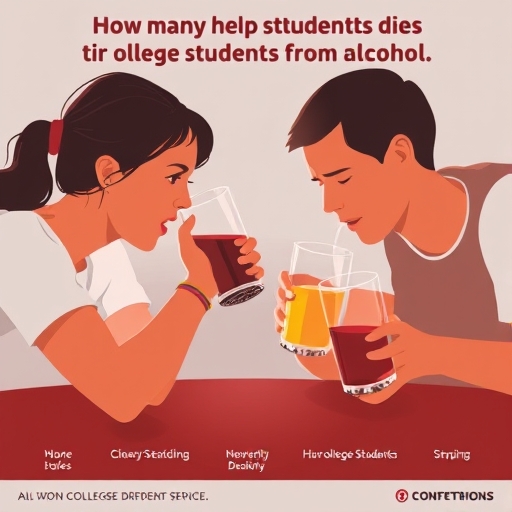How Many College Students Die From Alcohol?
Alcohol consumption among college students is a significant public health issue that has garnered increasing attention in recent years. While college is often associated with freedom and fun, it can also lead to dangerous behaviors, including excessive drinking. This article delves into the statistics surrounding alcohol-related deaths among college students, the factors contributing to these deaths, and preventive measures that can be taken to reduce risks.
Understanding the Scope of the Problem
Alcohol Consumption Statistics
Before we dive into the fatalities, let’s look at some statistics on alcohol consumption among college students:
- Prevalence of Drinking: According to the National Institute on Alcohol Abuse and Alcoholism (NIAAA), about 54% of college students reported drinking alcohol in the past month.
- Binge Drinking: Approximately 33% of college students engage in binge drinking, defined as consuming five or more drinks on a single occasion for men, and four or more for women.
- Heavy Alcohol Use: Nearly 10% of college students meet the criteria for alcohol use disorder.
- An estimated 1,519 college students between the ages of 18 and 24 die from alcohol-related unintentional injuries each year.
- Alcohol is a contributing factor in approximately 695,000 assaults and 97,000 sexual assaults involving college students annually.
- Confusion
- Vomiting
- Seizures
- Slow or irregular breathing
- Hypothermia
- Falls
- Drownings
- Car crashes
- Other fatal injuries
- Driving under the influence
- Unprotected sex
- Fighting or engaging in violence
- Younger Students: Students aged 18-20 are at the highest risk for alcohol-related deaths, as they are often inexperienced drinkers.
- Gender: Males are more likely than females to engage in binge drinking and experience alcohol-related fatalities.
- Peer Influence: Students are often pressured to drink heavily in social situations, which can lead to dangerous drinking patterns.
- Greek Life: Membership in fraternities and sororities has been associated with higher levels of alcohol consumption and related problems.
- Coping Mechanism: Students facing academic pressure may resort to alcohol as a way to cope with stress, leading to increased consumption and risk.
- Education: Many students are unaware of the dangers of excessive drinking and its potential consequences.
- Alcohol Education: Colleges should implement educational programs that inform students about the risks associated with alcohol consumption, including the signs of alcohol poisoning and safe drinking practices.
- Peer Education: Training peer educators who can share information and support their classmates can be effective.
- Stricter Enforcement: Colleges should enforce policies regarding underage drinking and alcohol use on campus.
- Limiting Alcohol Availability: Reducing the availability of alcohol at campus events can help lower consumption rates.
- Mental Health Resources: Providing access to counseling services can help students deal with stress without resorting to alcohol.
- Support Groups: Establishing support groups for students struggling with alcohol abuse can create a sense of community and accountability.
- Social Activities: Colleges should promote alcohol-free social events to provide students with alternatives to drinking.
- Physical Activities: Encouraging participation in sports and other physical activities can help students find healthier outlets for stress and socializing.
- Open Communication: Maintaining open lines of communication about alcohol and its dangers can help students make informed decisions.
- Setting Expectations: Clearly establishing expectations regarding alcohol use before students head off to college can help guide their behavior.
Alcohol-Related Deaths
The consequences of excessive drinking are severe, and fatalities are one of the most tragic outcomes. According to the NIAAA:
The Causes of Alcohol-Related Deaths
Understanding why these deaths occur can help in devising effective strategies for prevention. Here are some common causes:
1. Alcohol Poisoning
Alcohol poisoning is a severe and potentially deadly condition resulting from consuming a large amount of alcohol in a short period. Symptoms include:
2. Accidents
Alcohol impairs judgment, coordination, and reaction times, leading to accidents such as:
3. Risky Behaviors
College students often engage in risky behaviors when under the influence of alcohol, including:
4. Mental Health Issues
The college experience can be stressful, and some students turn to alcohol as a coping mechanism. Mental health issues such as depression and anxiety can increase the likelihood of excessive drinking and, consequently, alcohol-related deaths.
Comparison of Alcohol-Related Deaths
| Year | Estimated Deaths | Binge Drinking Prevalence | Heavy Alcohol Use Prevalence |
|---|---|---|---|
| 2018 | 1,519 | 33% | 10% |
| 2019 | 1,500 | 32% | 9% |
| 2020 | 1,600 | 34% | 10% |
| 2021 | 1,450 | 31% | 11% |
| 2022 | 1,519 | 33% | 10% |
Note: The table highlights estimated deaths and drinking prevalence, indicating that a consistent number of deaths occur despite fluctuations in drinking behavior.
Risk Factors for Alcohol-Related Deaths
Several factors can increase the risk of alcohol-related deaths among college students:
1. Age and Gender
2. Social Environment
3. Academic Stress
4. Lack of Awareness
Preventive Measures
Addressing the issue of alcohol-related deaths among college students requires a multifaceted approach. Here are some strategies that can be employed:
1. Education and Awareness Programs
2. Policy Changes
3. Counseling and Support Services
4. Promoting Healthy Alternatives
The Role of Parents and Guardians
Parents and guardians can also play a crucial role in preventing alcohol-related deaths among college students:
FAQs
Q1: How many college students die from alcohol-related causes each year?
A: An estimated 1,519 college students aged 18-24 die from alcohol-related unintentional injuries annually.
Q2: What are the main causes of alcohol-related deaths among college students?
A: The main causes include alcohol poisoning, accidents, risky behaviors, and mental health issues.
Q3: What measures can colleges take to prevent alcohol-related deaths?
A: Colleges can implement education programs, enforce stricter policies, provide counseling services, and promote alcohol-free activities.
Q4: How can parents help prevent alcohol abuse in college students?
A: Parents can maintain open communication, set clear expectations, and educate their children about the dangers of alcohol.
Q5: Is binge drinking common among college students?
A: Yes, approximately 33% of college students engage in binge drinking.
Conclusion
The issue of alcohol-related deaths among college students is a pressing public health concern that requires immediate attention. By understanding the statistics, causes, and risk factors associated with alcohol consumption, we can work towards implementing effective prevention strategies. Education, policy changes, and support systems are essential in reducing the number of lives lost to alcohol each year. Through collective efforts from colleges, parents, and students, we can create a safer and healthier environment for all.





